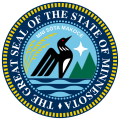| |||||||||||||||||
| |||||||||||||||||
| |||||||||||||||||
The 1871 Minnesota lieutenant gubernatorial election was held on November 7, 1871, in order to elect the lieutenant governor of Minnesota. Republican nominee and incumbent lieutenant governor William H. Yale defeated Democratic nominee David L. Buell and Temperance nominee William A. Bentley. [1]


